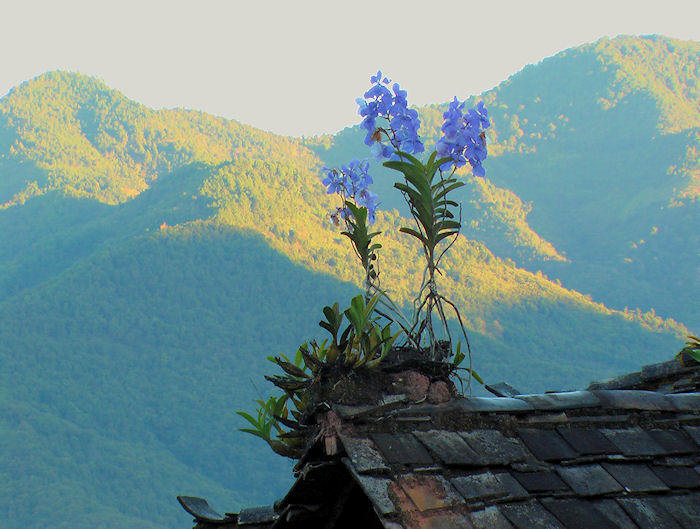

Xishuangbanna- Traum und Realität
Auszug aus dem Vorwort des Buches " Xishuangbanna: ein
Naturschutzgebiet in China":
"With its
evergreen mountains and breath-taking scenery, Xishuangbanna, located in the
south of China's Yunnan Province, is often referred to as the "Kingdom of
Plants" or "A Green Gem in the Imperial Botanical Crown". The
region is blessed with marvelous virgin forests, tropical rain forests,
abundant flora and fauna as well as ancient and charming minority cultures.
This wonderland enjoys an international fame for its rich, brilliant and
diverse scenic beauty, attracting scholars and tourists from both at home
and abroad.
The advantageous natural conditions have given the area a great variety of
forest vegetation, plants and wildlife. Here ancient tropical plants which
have been bypassed by the evolutionary process may be seen flourishing.
Plants of different geological ages and species blend to form wonderful
plant communities peculiar to Xishuangbanna. When the sun rises to clear
away the mists, precious flowers and plants embrace you with their
intoxicating scent floating in the air. Here grow Chinese parashoreas (Parashorea
chinensis) which seem to touch the zenith, and barely noticeable fungi of
unique beauty. Giant lianas also meander through the forest and epiphytic
orchids cling to tree trunks bursting in a cascade of delicate,
transparent flowers.
Penetrating deep into the jungle brings you into the presence of butterflies
flying among flowers, birds singing, troops of apes and monkeys
playing among the trees agilely and merrily or the shadows of wild
elephants walking leisurely in groups in the banana woods. These "residents"
live in harmony in the thick forests of Xishuangbanna -- a paradise that
belongs to them alone. Some of China's rarest animals can be found here,
including the Asiatic elephant (Elephas maximus), Indian wild ox (Bos gaurus), Indo-Chinese tiger (Panthera tigris), white-cheeked gibbon (Hylobates concolor leucogenys), binturong (Arctictic binturong),
chevrotain (Tragulus javanicus), brown-headed hornbill (Aceros nipalensis), peacock pheasant (Polypleotron bicalcaratum) and green peacock (Paro
muticus). Xishuangbanna covers less than 0.2% of the total land area of
China, yet it is here that more than 4000 species of higher plants and
over 600 species of vertebrates have been discovered. It boasts 50% of
China's rare and endangered plants under state protection."
Nachdem ich das gelesen hatte, glaubte ich mein Wunderland, mein Paradies
gefunden zu haben. Also auf nach Xishuangbanna!
Was sahen wir in 10 Tagen wandern durch Felder, kühle Bergwälder und
feuchtwarme Regenwälder im Dezember 2005:
Keine Affen und keine Elefanten, auch keine Pfauen und absolut keine anderen
Wirbeltiere, außer Rinder, Schweine und Hühner in und um die Dörfer.
Keine Orchideen, abgesehen von einem herrlichen Exemplar von
Vanda coerulea, der Blauen Orchidee auf dem
Dach eines Hauses der Bulang und nahezu keine andere Wildblume.
Das etwa 20.000 km² große Areal von Xishuangbanna war einst von Dschungel
bedeckt. Heute sind die Flussebenen des Mekong in Reis- und Gemüsefelder
umgewandelt und die Berge und Hügel wurden für Kautschuk-Plantagen
abgeholzt. Nur noch 15 % von Xishuangbanna ist von Dschungel bedeckt und das
reicht sicher nicht für Elefantenherden.
Ich bin wieder mal zu spät gekommen!
